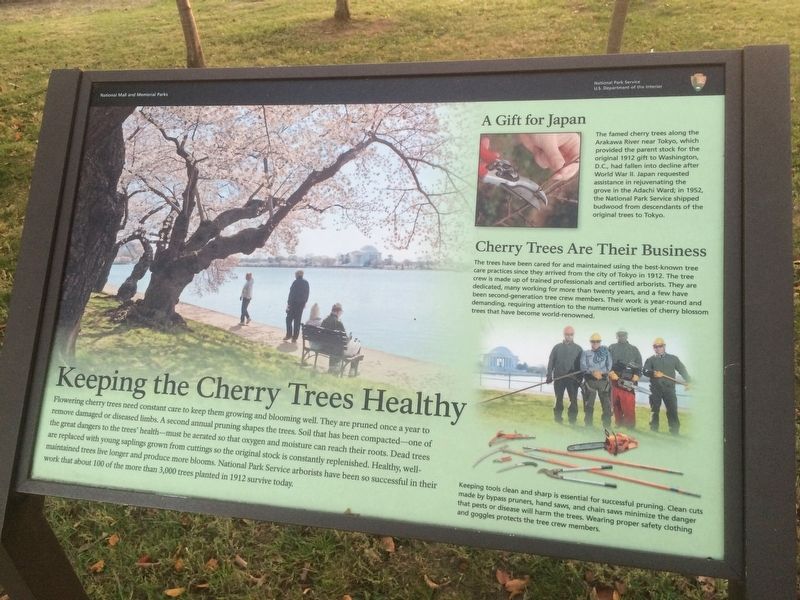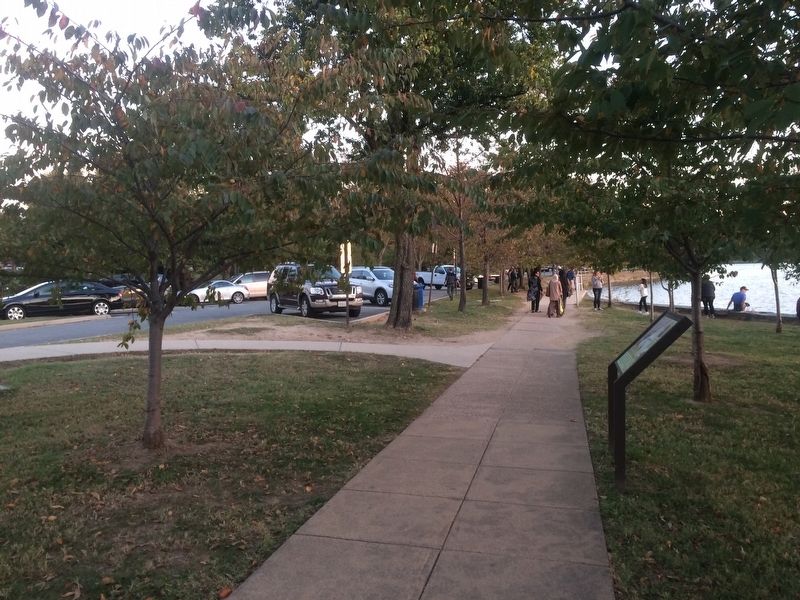The Tidal Basin in Southwest Washington in Washington, District of Columbia — The American Northeast (Mid-Atlantic)
Keeping the Cherry Trees Healthy
National Mall and Memorial Parks
— National Park Service, U.S. Department of the Interior —
Flowering cherry trees need constant care to keep them growing and blooming well. They are pruned once a year to remove damaged or diseased limbs. A second annual pruning shapes the trees. Soil that has been compacted – one of the great dangers to the trees’ health – must be aerated so that oxygen and moisture can reach their roots. Dead trees are replaced with young saplings grown from cuttings so the original stock is constantly replenished. Healthy, well-maintained trees live longer and produce more blooms. National Park Service arborists have been so successful in their work that about 100 of the more than 3,000 trees planted in 1912 survive today.
A Gift for Japan
The famed cherry trees along the Arakawa River near Tokyo, which provided the parent stock for the original 1912 gift to Washington, D.C., had fallen into decline after World War II. Japan requested assistance in rejuvenating the grove in the Adachi Ward; in 1952, the National Park Service shipped budwood from descendants of the original trees to Tokyo.
Cherry Trees Are Their Business
The trees have been cared for and maintained using the best-known tree care practices since they arrived from the city of Tokyo in 1912. The tree crew is made up of trained professionals and certified arborists. They are dedicated, many working for more than twenty years, and a few have been second-generation tree crew members. Their work is year-round and demanding, requiring attention to the numerous varieties of cherry blossom trees that have become world-renowned.
Keeping tools clean and sharp is essential for successful pruning. Clean cuts made by bypass pruners, hand saws, and chain saws minimize the danger that pests or disease will harm the trees. Wearing proper clothing and googles protects the tree crew members.
Erected by National Park Service, U.S. Department of the Interior.
Topics. This historical marker is listed in these topic lists: Environment • Horticulture & Forestry. A significant historical year for this entry is 1912.
Location. 38° 53.202′ N, 77° 2.263′ W. Marker is in Southwest Washington in Washington, District of Columbia. It is in The Tidal Basin. Marker is on Independence Avenue Southwest west of Maine Avenue Southwest, on the right when traveling east. The marker is along the walking path around the Tidal Basin, near the Floral Library and the eastern end of the Kutz Bridge. Touch for map. Marker is in this post office area: Washington DC 20024, United States of America. Touch for directions.
Other nearby markers. At least 8 other markers are within walking distance of this marker. The Gift of Trees (about 700 feet away, measured in a direct line); John Paul Jones Memorial (about 800 feet away); a different marker also named John Paul Jones Memorial (about 800 feet away); Washington Monument (approx. 0.2 miles away); Washington: The City (approx. 0.2 miles away); Washington: The Monument (approx. 0.2 miles away); Washington: The Man (approx. 0.2 miles away); Lighting the Way (approx. 0.2 miles away). Touch for a list and map of all markers in Southwest Washington.
Credits. This page was last revised on January 30, 2023. It was originally submitted on December 2, 2016, by J. Makali Bruton of Accra, Ghana. This page has been viewed 411 times since then and 10 times this year. Photos: 1, 2. submitted on December 2, 2016, by J. Makali Bruton of Accra, Ghana.

